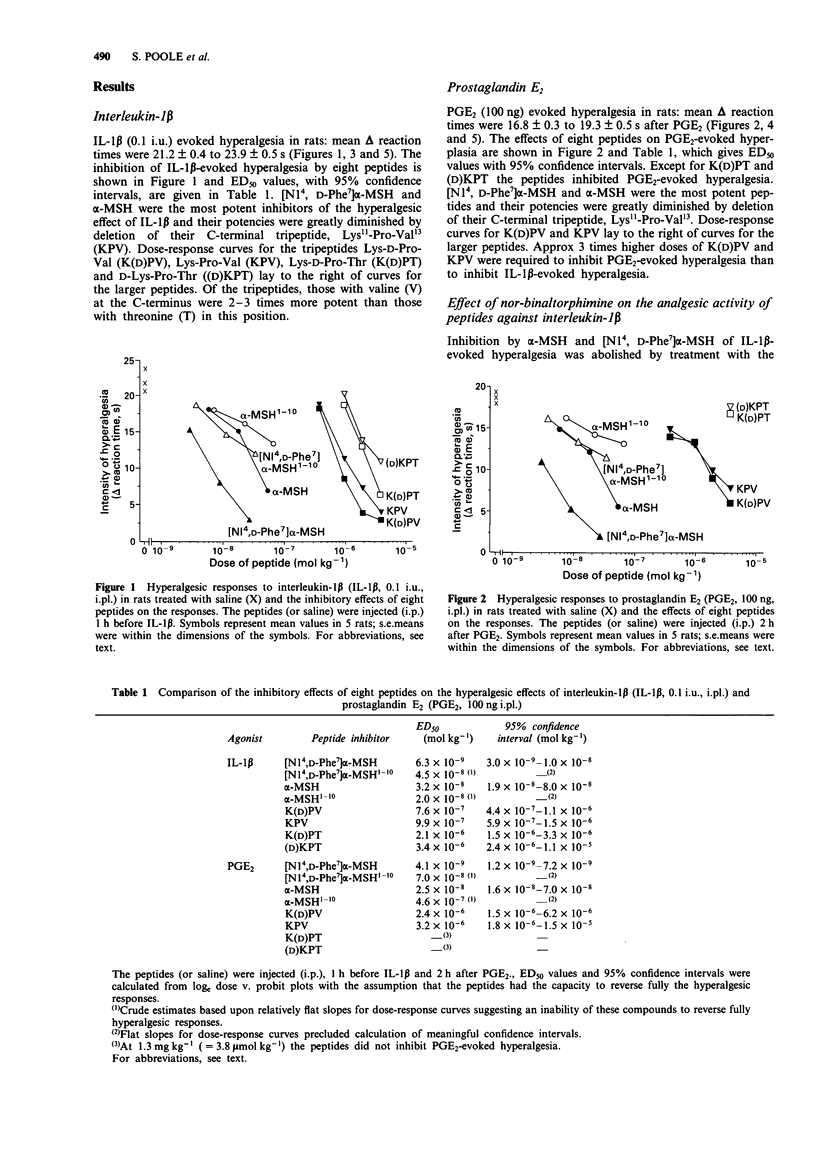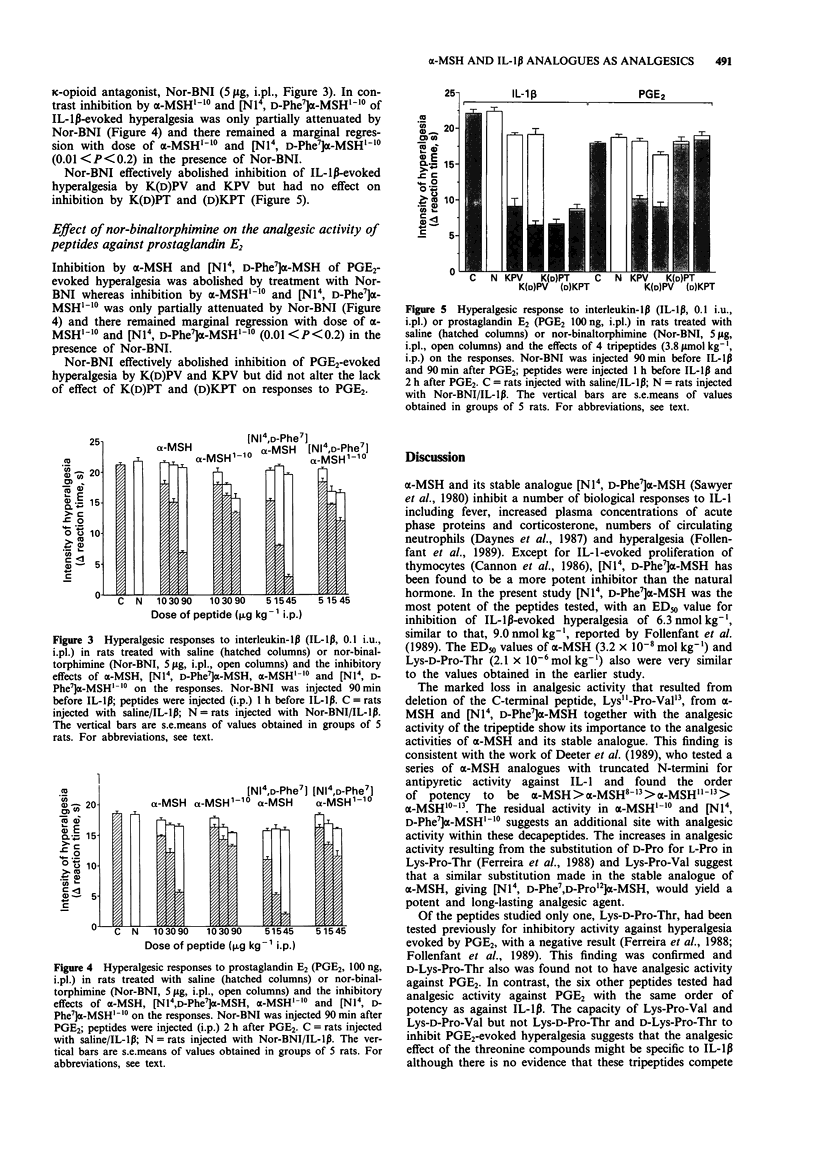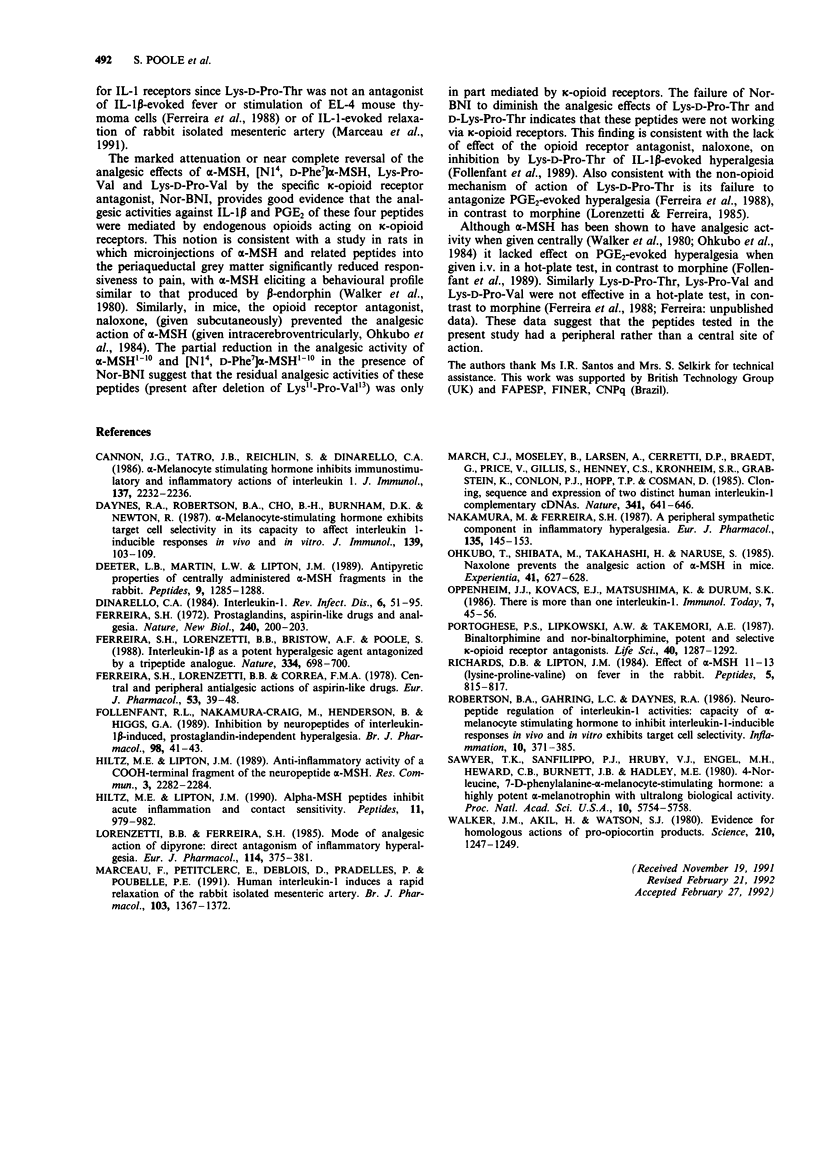Abstract
1. The hyperalgesic effects of interleukin-1 beta (IL-1 beta) and prostaglandin E2 (PGE2) were measured in rats. 2. Hyperalgesic responses to IL-1 beta were inhibited in a dose-dependent manner by alpha-melanocyte stimulating hormone (alpha-MSH)-related peptides with the following order of potency: [N1(4),D-Phe7]alpha-MSH greater than alpha-MSH greater than Lys-D-Pro-Val greater than Lys-Pro-Val greater than Lys-D-Pro-Thr greater than D-Lys-Pro-Thr. 3. Hyperalgesic responses to PGE2 were not inhibited by Lys-D-Pro-Thr and D-Lys-Pro-Thr but were inhibited in a dose-dependent manner by the other peptides with the same order of potency as against IL-1 beta. 4. The potencies of [N1(4), D-Phe7]alpha-MSH and alpha-MSH were greatly diminished by deletion of their C-terminal tripeptide, Lys11-Pro-Val13. 5. Nor-binaltorphimine (Nor-BNI) largely reversed the analgesic effects of alpha-MSH, [N1(4), D-Phe7]alpha-MSH, Lys-Pro-Val and Lys-D-Pro-Val indicating that kappa-opioid receptors mediated the analgesic activity of these peptides. 6. Nor-BNI did not antagonize the inhibition by Lys-D-Pro-Thr and D-Lys-Pro-Thr of IL-1 beta evoked hyperalgesia indicating that these peptides were not acting via kappa-opioid receptors.
Full text
PDF



Selected References
These references are in PubMed. This may not be the complete list of references from this article.
- Cannon J. G., Tatro J. B., Reichlin S., Dinarello C. A. Alpha melanocyte stimulating hormone inhibits immunostimulatory and inflammatory actions of interleukin 1. J Immunol. 1986 Oct 1;137(7):2232–2236. [PubMed] [Google Scholar]
- Daynes R. A., Robertson B. A., Cho B. H., Burnham D. K., Newton R. Alpha-melanocyte-stimulating hormone exhibits target cell selectivity in its capacity to affect interleukin 1-inducible responses in vivo and in vitro. J Immunol. 1987 Jul 1;139(1):103–109. [PubMed] [Google Scholar]
- Deeter L. B., Martin L. W., Lipton J. M. Antipyretic properties of centrally administered alpha-MSH fragments in the rabbit. Peptides. 1988 Nov-Dec;9(6):1285–1288. doi: 10.1016/0196-9781(88)90193-3. [DOI] [PubMed] [Google Scholar]
- Dinarello C. A. Interleukin-1. Rev Infect Dis. 1984 Jan-Feb;6(1):51–95. doi: 10.1093/clinids/6.1.51. [DOI] [PubMed] [Google Scholar]
- Ferreira S. H., Lorenzetti B. B., Bristow A. F., Poole S. Interleukin-1 beta as a potent hyperalgesic agent antagonized by a tripeptide analogue. Nature. 1988 Aug 25;334(6184):698–700. doi: 10.1038/334698a0. [DOI] [PubMed] [Google Scholar]
- Ferreira S. H., Lorenzetti B. B., Corrêa F. M. Central and peripheral antialgesic action of aspirin-like drugs. Eur J Pharmacol. 1978 Dec 15;53(1):39–48. doi: 10.1016/0014-2999(78)90265-0. [DOI] [PubMed] [Google Scholar]
- Ferreira S. H. Prostaglandins, aspirin-like drugs and analgesia. Nat New Biol. 1972 Dec 13;240(102):200–203. doi: 10.1038/newbio240200a0. [DOI] [PubMed] [Google Scholar]
- Follenfant R. L., Nakamura-Craig M., Henderson B., Higgs G. A. Inhibition by neuropeptides of interleukin-1 beta-induced, prostaglandin-independent hyperalgesia. Br J Pharmacol. 1989 Sep;98(1):41–43. doi: 10.1111/j.1476-5381.1989.tb16860.x. [DOI] [PMC free article] [PubMed] [Google Scholar]
- Hiltz M. E., Lipton J. M. Alpha-MSH peptides inhibit acute inflammation and contact sensitivity. Peptides. 1990 Sep-Oct;11(5):979–982. doi: 10.1016/0196-9781(90)90020-6. [DOI] [PubMed] [Google Scholar]
- Hiltz M. E., Lipton J. M. Antiinflammatory activity of a COOH-terminal fragment of the neuropeptide alpha-MSH. FASEB J. 1989 Sep;3(11):2282–2284. [PubMed] [Google Scholar]
- Lorenzetti B. B., Ferreira S. H. Mode of analgesic action of dipyrone: direct antagonism of inflammatory hyperalgesia. Eur J Pharmacol. 1985 Aug 27;114(3):375–381. doi: 10.1016/0014-2999(85)90383-8. [DOI] [PubMed] [Google Scholar]
- Marceau F., Petitclerc E., DeBlois D., Pradelles P., Poubelle P. E. Human interleukin-1 induces a rapid relaxation of the rabbit isolated mesenteric artery. Br J Pharmacol. 1991 Jun;103(2):1367–1372. doi: 10.1111/j.1476-5381.1991.tb09795.x. [DOI] [PMC free article] [PubMed] [Google Scholar]
- Nakamura M., Ferreira S. H. A peripheral sympathetic component in inflammatory hyperalgesia. Eur J Pharmacol. 1987 Mar 17;135(2):145–153. doi: 10.1016/0014-2999(87)90606-6. [DOI] [PubMed] [Google Scholar]
- Ohkubo T., Shibata M., Takahashi H., Naruse S. Naloxone prevents the analgesic action of alpha-MSH in mice. Experientia. 1985 May 15;41(5):627–628. doi: 10.1007/BF02007691. [DOI] [PubMed] [Google Scholar]
- Portoghese P. S., Lipkowski A. W., Takemori A. E. Binaltorphimine and nor-binaltorphimine, potent and selective kappa-opioid receptor antagonists. Life Sci. 1987 Mar 30;40(13):1287–1292. doi: 10.1016/0024-3205(87)90585-6. [DOI] [PubMed] [Google Scholar]
- Richards D. B., Lipton J. M. Effect of alpha-MSH 11-13 (lysine-proline-valine) on fever in the rabbit. Peptides. 1984 Jul-Aug;5(4):815–817. doi: 10.1016/0196-9781(84)90027-5. [DOI] [PubMed] [Google Scholar]
- Robertson B. A., Gahring L. C., Daynes R. A. Neuropeptide regulation of interleukin-1 activities. Capacity of alpha-melanocyte stimulating hormone to inhibit interleukin-1-inducible responses in vivo and in vitro exhibits target cell selectivity. Inflammation. 1986 Dec;10(4):371–385. doi: 10.1007/BF00915821. [DOI] [PubMed] [Google Scholar]
- Sawyer T. K., Sanfilippo P. J., Hruby V. J., Engel M. H., Heward C. B., Burnett J. B., Hadley M. E. 4-Norleucine, 7-D-phenylalanine-alpha-melanocyte-stimulating hormone: a highly potent alpha-melanotropin with ultralong biological activity. Proc Natl Acad Sci U S A. 1980 Oct;77(10):5754–5758. doi: 10.1073/pnas.77.10.5754. [DOI] [PMC free article] [PubMed] [Google Scholar]
- Walker J. M., Akil H., Watson S. J. Evidence for homologous actions of pro-opiocortin products. Science. 1980 Dec 12;210(4475):1247–1249. doi: 10.1126/science.6254152. [DOI] [PubMed] [Google Scholar]


